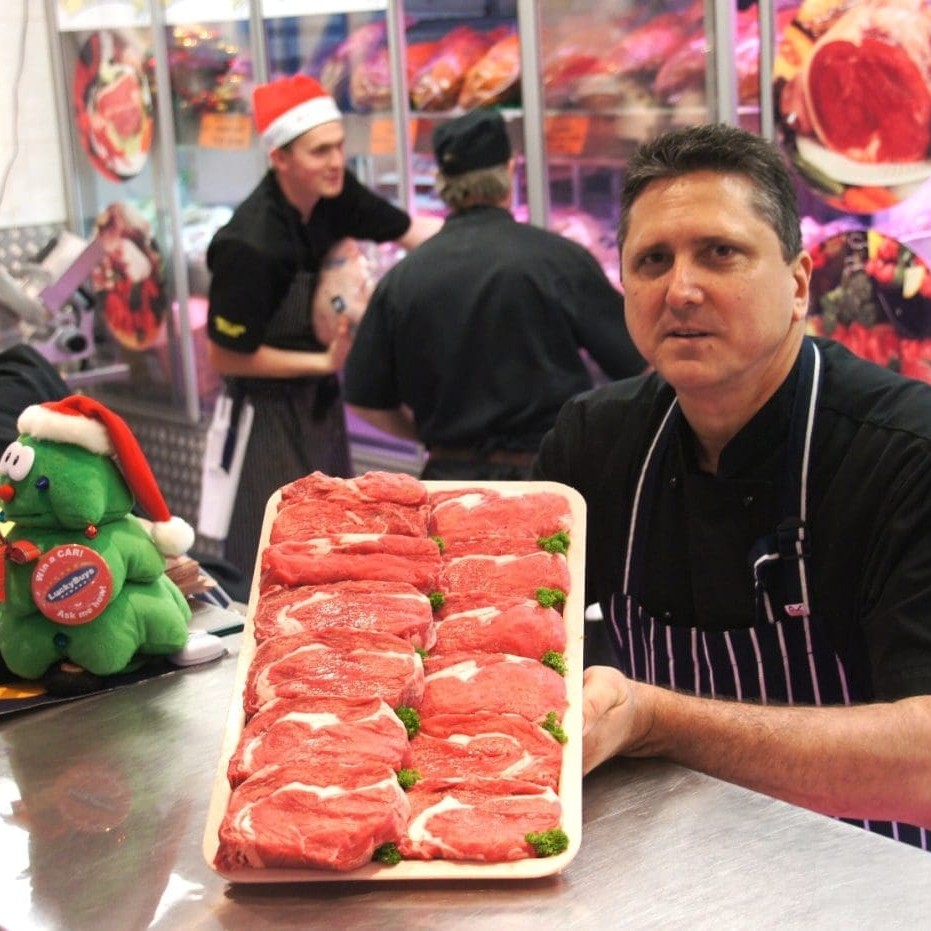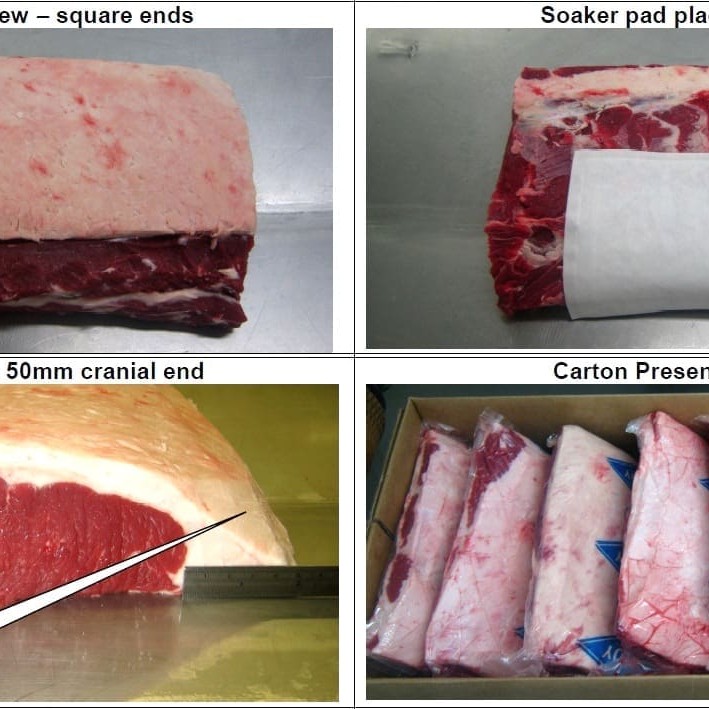 Retail butchers have logged surprisingly strong meat sales during December, with one major wholesaler reporting many of their retail customers were up 15-25 percent on turnover recorded in December trade a year earlier.
Retail butchers have logged surprisingly strong meat sales during December, with one major wholesaler reporting many of their retail customers were up 15-25 percent on turnover recorded in December trade a year earlier.
The trend is reflected also in the MLA-commissioned December butcher survey which indicated that 36pc of butchers rated December beef sales as ‘very good’ to ‘excellent’.
The survey, conducted by conducted by Millward Brown, found a further 45pc of butchers noted ‘good’ beef sales for the month. The most popular beef cuts during December were steaks; including striploin, T-bone, rump and cube-roll, with product quality, price and the onset of the barbeque season reportedly the main drivers.
Australian Meat Industry Council’s national retail chairman, Ray Kelso, acknowledged the trend, saying it had been consistently evident from Western Australia to Victoria and north into Queensland.
“We had a councillor phone hook-up in late November when the general feedback was that retail trade was quite slow to that point, but sales really picked up through to Christmas, judging by later comments,” Mr Kelso said.
The trend had applied to beef just as strongly as traditional Christmas meats like ham, turkey and pork.
“The consistent pattern seemed to be that December trade was pretty strong all the way through for many butchers, whereas normally there is a mad rush limited to the last two weeks,” Mr Kelso said.
While reasons were difficult to pin-down, given the general flatness in the economy and in consumer confidence, relatively good barbecuing weather and cooler conditions during December may have contributed.
While traditionally butchers hit a flat spot after Christmas/New year due to the abundance of hams in fridges across the country, trade in early stages of January was also looking encouraging.
“We generally find February is a quieter month, with credit card bills and household costs associated with children heading back to school,” Mr Kelso said. “But increasingly, trading patterns are changing. Ten years ago we could almost bank on a given turnover at different weeks around Christmas. But traditional patterns do not seem to follow so closely any more.”
Mr Kelso said while there was a little evidence of short supply in wholesale meat due to recent abattoir holiday and seasonal closures, MSA boxed beef prices had varied little since November. In his own business, he was currently paying around $9/kg for MSA rumps, strips $15/kg and cube roll, $23/kg.
Pressure on for lighter MSA cuts
One of Beef Central’s reliable wholesale sector contacts with a large footprint across Eastern Australia said there was evidence in the market at present that retailers generally were pushing for more uniformity in primal size, as well as smaller portion size.
“They want to be able to place four steaks on a tray instead of three, to give customers the impression they are getting value for money,” he said.
“Increasingly, each primal in a carton has to cut so it looks like the picture on the lid of the box, because butchers want that consistency so they can put it straight into the window.”
Primal weight variance in a carton made that harder to do, and because of the lack of skilled butchers around, some ‘butchers’ these days were little more than meat ‘cutters’, meaning they needed a more uniform product with which to work.
Interestingly, some of the many MSA brands now available in the market were gaining a reputation for consistency of primal size and presentation, while for others, the reverse was applying, and they were beginning to be penalised in the marketplace.
“There is no doubt that uniformity is now a much greater priority in the MSA brand story,” the wholesaler said.
“Once cattle get outside those more desirable MSA weight-ranges, that becomes harder. It applies to lamb as much as beef: Woolworths has recently applied price penalties in the south on those lambs above 24kg carcase weight, for the same reason. And the same trend is being seen in many meatworks grids, where those 280-320kg, 100-day bodies now sell at a premium over 320-400kg.”
Beef Central’s wholesaler contact said he believed that would be a noticeable trend going forward in 2012, particularly if cattle again recorded good weightgain following another good season.
“Within the MSA supply spectrum, the issue is going to be on light MSA,” he said.
“Obviously Coles and Woolworths are paying a premium on those four loin cuts, which is applying a bit of pressure on butchers. But the lighter end is definitely where the deficit is at present.”
This was illustrated in price variance within MSA cuts in the wholesale marketplace at present. Depending on size, MSA cube rolls are currently selling anywhere from $21 to $24/kg for better brands and lighter weights. Similarly, as soon as rumps lift above 6-7kg in weight, price starts to suffer. Wholesale prices are currently $6.50/$7 to $8.50/$9 for better and smaller examples.
“As soon you get light meat where retailers can sell the cut whole, there is a price distinction, and that gap has widened,” he said.
Striploin ‘under-performer’
 Striploins remained arguably the biggest ‘under-performing’ cut across the domestic grilling spectrum over the past year or two.
Striploins remained arguably the biggest ‘under-performing’ cut across the domestic grilling spectrum over the past year or two.
While a little more popular in southern states like SA, Tasmania and Victoria, strips were much harder to shift in NSW and Queensland, where the popular preference was for cube-roll or rump.
Current MSA wholesale prices for striploin are anywhere from $9-$10 to $14/kg for better examples. Players in the market are trying to keep them in the $12s to $14s range, but big swings are still in evidence.
“Striploin is one of the cuts that operators must get their value out of, otherwise it makes it that much harder to optimise return from the overall carcase,” Beef Central’s wholesaler contact said.
Several smart operators are doing things with larger striploins to make them a more saleable item on the domestic market, size-wise.
An example is Kilcoy Pastoral Co’s ‘steak-ready’ striploin product taken from 100-day meat – chain-off, right down the backbone. While chain-off treatment of striploins has been done for years for the EU market, it is much less familiar in the domestic wholesale trade. The process leaves the primal virtually ready to portion-control work.
As illustrated in the accompanying product spec photos from Kilcoy, the process takes a heavier item and does things with it to make it more feasible for the heavier end of the domestic market.
“It doesn’t stop them from being big pieces of meat – but the perception for catering or cutting-rooms is that they are easier to handle,” the wholesaler said.
More of these little ‘bits and pieces’ were now being done at the meatworks level, rather than in the cutting-room or at the butcher shop. While there is obviously a yield sacrifice which must be covered in price, such processes add convenience and make the product more versatile.
Lamb new retail battleground?
Beef Central’s wholesaler contact suggested lamb could emerge as this year’s major battleground between independents and supermarkets.
“Supermarket supply chains rely on vacuum packaging to deliver shelf-life to get product into stores. By the time it passes through their distribution centres and into the stores, it’s three or four weeks in the bag.
“Lamb does not cryovac near as well as beef, particularly bone-in, and can often be left sticky to the touch. Butchers, cutting lamb fresh in the shop have a distinct advantage, which they are likely to exploit. The difference is chalk and cheese,” the wholesaler said.
Butchers generally seemed to be gaining a little more traction again in their retail battle with Woolworths and Coles, he said.
